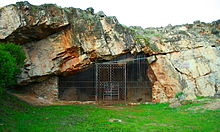كهف مالترافيسو

كهف مالترافيسو في كاسيريس، إكستريمادورا، إسبانيا، في عام 1951. يُظهر آثار الاستيطان البشري من العصر الحجري القديم الأوسط . يحتوي على رسوم الكهوف، وأبرزها ما مجموعه 71 رسمًا يدويًا، تم تعدادها في التسعينيات باستخدام التصوير فوق البنفسجي،[2] ولكن أيضًا تصميمات خطية وبعض اللوحات الحيوانية. في دراسة أجريت عام 2018 على أساس تأريخ اليورانيوم والثوريوم، تم تأريخ استنسل يدوي من كهف مالترافييسو إلى 64000 عام. هذا سيجعله فنًا من العصر الحجري القديم الأوسط، يسبق وجود الإنسان الأوروبي الحديث المبكر، مع آثار مهمة على سلوك الإنسان البدائي.[3]
افتتح مركز الزوار (بالإسبانية: Centro de Interpretación de la Cueva de Maltravieso) ، في عام 1999. كهوف العصر الحجري القديم الأخرى القريبة هي تلك الموجودة في El Conejar وسانتا آنا وكاستانيار دي إيبور.
روابط خارجية
[عدل]المراجع
[عدل]- ^ ا ب "Wiki Loves Monuments monuments database". 13 نوفمبر 2017.
- ^ Sergio Ripoll López, E. Ripoll Perelló, H. Collado Giraldo, M. Mas Cornellá, J.F. Jordá Pardo y Laboratorio de Estudios Paleolíticos (1999): "Maltravieso. El santuario extremeño de las manos", Trabajos de Prehistoria vol. 56, issue 2, pp. 21–33.
- ^ D. L. Hoffmann؛ C. D. Standish؛ M. García-Diez؛ P. B. Pettitt؛ J. A. Milton؛ J. Zilhão؛ J. J. Alcolea-González؛ P. Cantalejo-Duarte؛ H. Collado؛ R. de Balbín؛ M. Lorblanchet؛ J. Ramos-Muñoz؛ G.-Ch. Weniger؛ A. W. G. Pike (2018). "U-Th dating of carbonate crusts reveals Neandertal origin of Iberian cave art". Science. ج. 359 ع. 6378: 912–915. DOI:10.1126/science.aap7778. PMID:29472483. "we present dating results for three sites in Spain that show that cave art emerged in Iberia substantially earlier than previously thought. Uranium-thorium (U-Th) dates on carbonate crusts overlying paintings provide minimum ages for a red linear motif in كهف لا باسيغا, a hand stencil in Maltravieso (Extremadura), and red-painted speleothems in أرداليس. Collectively, these results show that cave art in Iberia is older than 64.8 thousand years (ka). This cave art is the earliest dated so far and predates, by at least 20 ka, the arrival of modern humans in Europe, which implies Neandertal authorship."
في كومنز صور وملفات عن Cave of Maltravieso.

